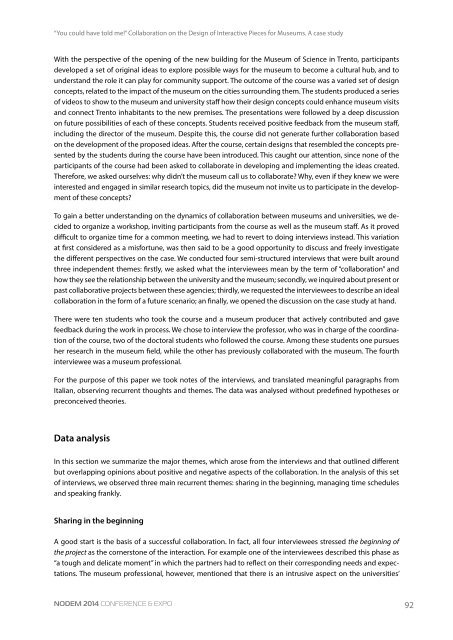NODEM 2014 Proceedings
NODEM 2014 Proceedings
NODEM 2014 Proceedings
You also want an ePaper? Increase the reach of your titles
YUMPU automatically turns print PDFs into web optimized ePapers that Google loves.
“You could have told me!” Collaboration on the Design of Interactive Pieces for Museums. A case study<br />
With the perspective of the opening of the new building for the Museum of Science in Trento, participants<br />
developed a set of original ideas to explore possible ways for the museum to become a cultural hub, and to<br />
understand the role it can play for community support. The outcome of the course was a varied set of design<br />
concepts, related to the impact of the museum on the cities surrounding them. The students produced a series<br />
of videos to show to the museum and university staff how their design concepts could enhance museum visits<br />
and connect Trento inhabitants to the new premises. The presentations were followed by a deep discussion<br />
on future possibilities of each of these concepts. Students received positive feedback from the museum staff,<br />
including the director of the museum. Despite this, the course did not generate further collaboration based<br />
on the development of the proposed ideas. After the course, certain designs that resembled the concepts presented<br />
by the students during the course have been introduced. This caught our attention, since none of the<br />
participants of the course had been asked to collaborate in developing and implementing the ideas created.<br />
Therefore, we asked ourselves: why didn’t the museum call us to collaborate? Why, even if they knew we were<br />
interested and engaged in similar research topics, did the museum not invite us to participate in the development<br />
of these concepts?<br />
To gain a better understanding on the dynamics of collaboration between museums and universities, we decided<br />
to organize a workshop, inviting participants from the course as well as the museum staff. As it proved<br />
difficult to organize time for a common meeting, we had to revert to doing interviews instead. This variation<br />
at first considered as a misfortune, was then said to be a good opportunity to discuss and freely investigate<br />
the different perspectives on the case. We conducted four semi-structured interviews that were built around<br />
three independent themes: firstly, we asked what the interviewees mean by the term of “collaboration” and<br />
how they see the relationship between the university and the museum; secondly, we inquired about present or<br />
past collaborative projects between these agencies; thirdly, we requested the interviewees to describe an ideal<br />
collaboration in the form of a future scenario; an finally, we opened the discussion on the case study at hand.<br />
There were ten students who took the course and a museum producer that actively contributed and gave<br />
feedback during the work in process. We chose to interview the professor, who was in charge of the coordination<br />
of the course, two of the doctoral students who followed the course. Among these students one pursues<br />
her research in the museum field, while the other has previously collaborated with the museum. The fourth<br />
interviewee was a museum professional.<br />
For the purpose of this paper we took notes of the interviews, and translated meaningful paragraphs from<br />
Italian, observing recurrent thoughts and themes. The data was analysed without predefined hypotheses or<br />
preconceived theories.<br />
Data analysis<br />
In this section we summarize the major themes, which arose from the interviews and that outlined different<br />
but overlapping opinions about positive and negative aspects of the collaboration. In the analysis of this set<br />
of interviews, we observed three main recurrent themes: sharing in the beginning, managing time schedules<br />
and speaking frankly.<br />
Sharing in the beginning<br />
A good start is the basis of a successful collaboration. In fact, all four interviewees stressed the beginning of<br />
the project as the cornerstone of the interaction. For example one of the interviewees described this phase as<br />
“a tough and delicate moment” in which the partners had to reflect on their corresponding needs and expectations.<br />
The museum professional, however, mentioned that there is an intrusive aspect on the universities’<br />
<strong>NODEM</strong> <strong>2014</strong> Conference & Expo<br />
92


